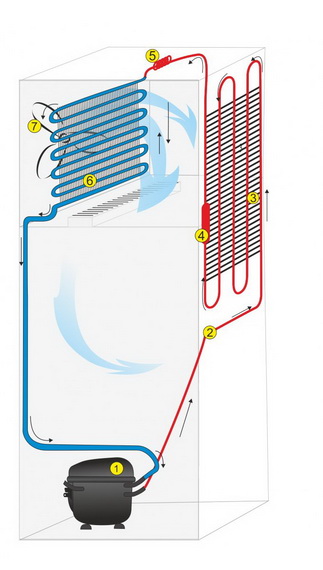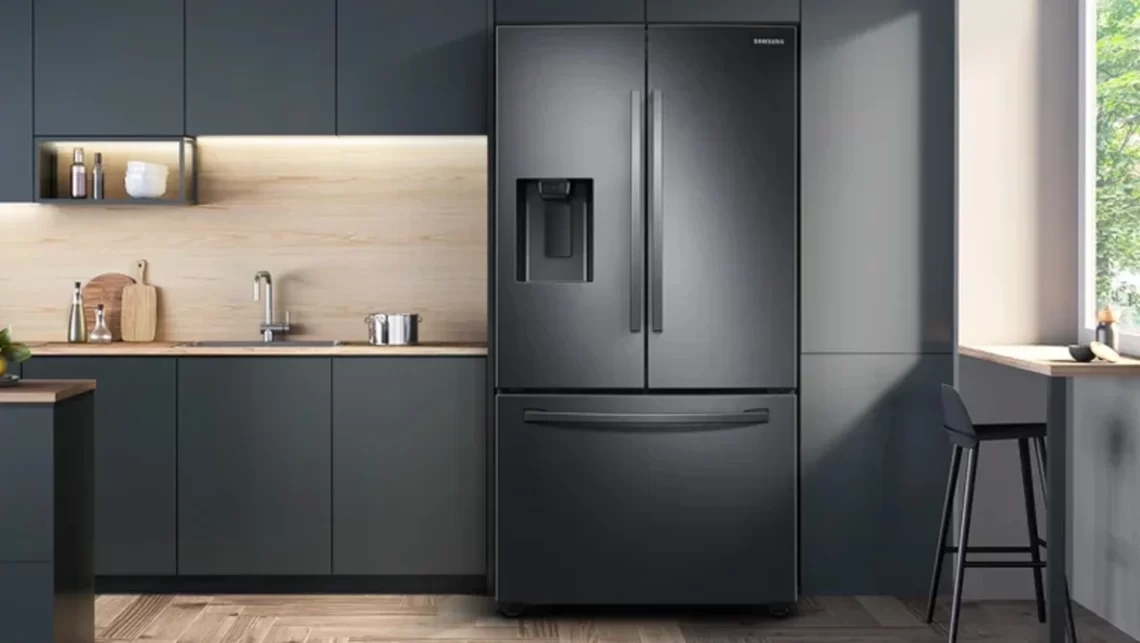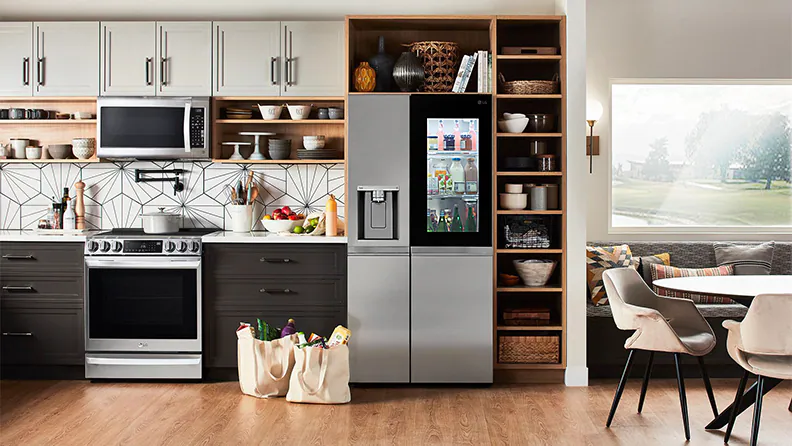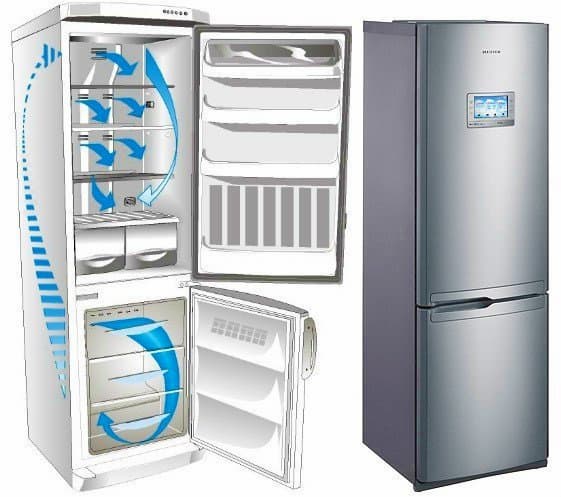Have you ever wondered how the refrigerators in your home work?
Refrigerators, which have become an integral part of every household, work based on some simple and interesting scientific principles. Beginning with the basic refrigerator model, this item will elaborate on the operation of modern refrigerators along with the secrets behind their high energy efficiency.

- Compressor
- Pressure tube
- Condencer
- Filter dryer
- Capillary tube
- Fridge’s evaporator
- Freezer’s evaporator
Basics

The basic principle of refrigerators is simple and the same for big or compact refrigerators. Simply pass a colder liquid continuously around the object to be cooled. Let’s see how this continuous cold liquid flow is achieved inside a refrigerator. A simple device called a throttling device is the most crucial component of refrigerators. Here, a capillary tube is used as a throttling device. A cold liquid is produced using the throttling phenomenon. For effective throttling at the inlet, the refrigerant should be at a liquid state under high pressure.
The throttling device is an obstruction to the flow, so a huge pressure drop occurs when the liquid flows through it. As the pressure drops, the boiling point of the liquid comes down. Thus the refrigerant liquid evaporates. The energy required for such evaporation comes from the refrigerant, so its temperature drops. If you check the temperature across the throttling device, you will notice this drop.
Please note that only a portion of the refrigerant is evaporated here. This is one important property of the refrigeration fluid. It should be able to change the phase while varying the pressure under normal temperatures. The next phase is simple, just pass this cold liquid over the body, which has to be cooled. During the heat absorption process, the refrigerant further evaporates and transforms into pure vapor. Since there is phase change during this process, the refrigerant temperature does not increase.
This heat exchanger is called the evaporator. With the help of clever airflow circulation inside the refrigerator using an evaporator fan, one can maintain different temperature levels. So we have produced the required refrigeration effect. If we could take this low-pressure refrigerant to the state before throttling, that is high-pressure liquid, we will be able to repeat this process.
Compressor

So the first step is to raise the pressure. A compressor is used for this purpose. The compressor will raise the pressure back to its initial value. Here is a reciprocating type compressor. However, since it is compressing gas along with pressure, the temperature will also increase. This is unavoidable. Now the refrigerant is high-pressure vapor. To convert it to a liquid stage, we introduce another heat exchanger. This heat exchanger is fitted outside of the refrigerator, thus, it will liberate heat to its surroundings. Vapor will be converted to liquid and temperature will reach a normal level.
Condenser
This heat exchanger is known as a condenser. Now, the refrigerant is back to its initial state, so it can be fed to the throttling device again. Just by repeating this cycle over and over, we will be able to achieve a continuous cooling effect. This cycle is more specifically called the vapor compression cycle.
Refrigerator performance can be evaluated using a term called coefficient of performance. Performance is output divided by input, so the coefficient of performance can be easily defined as follows. This is the most basic refrigerator possible ever. This refrigerator will work well in theory. However, in practice, it will face many issues. Let’s see what these issues are and how to overcome them.
Freezer
One major issue is the frost developed in the freezer compartment. The circulated air has moisture content inside it, so when the air comes in contact with the cold evaporator coil, they will condense and form a frost around the coil. Such ice coating prevents further heat transfer, and the refrigerator becomes inefficient over time.
One great way to solve this issue is to remove frost occasionally with the help of a heating rod, this is why you could see a pan and water condensate at the bottom of your refrigerator.
Moreover, in modern refrigerators, you won’t be able to see the condenser fans at the back of the refrigerator. Instead, they use a compact condenser arrangement. This compact arrangement is assisted by a cooling fan, and the same heat rejection purpose is achieved here. The hot air expelled by the fan can be used to effectively evaporate the water condensate formed during the frosting. The improved refrigerator looks like this. Interesting temperature distribution in different parts of their refrigerator is illustrated here. The temperature drop across the capillary tube is also clearly depicted here. You can notice two refrigerant lines outside the refrigerators. One takes the cold liquid from the capillary tube to the evaporator coil and the other, the exit vapor line from the evaporator.
However, if you check your home refrigerator, you can see only one line on the outside. Why is this the case? The most crucial part of the refrigerator is the capillary tube, which need not be a spring-like device. It could be a long straight tube as shown. Temperature variation in the new straight capillary tube is depicted here. You see only one line on your home refrigerator because this straight capillary tube runs inside the evaporator exit coil. This simple technique has major advantages.

We know that during the heat absorption process at the evaporator, the refrigerant temperature does not rise, only its phase changes. This means that if we allow the capillary tube to come into contact with the evaporator exit line, this will bring down the capillary tube refrigerant temperature by a great degree. This effect will lead to greater temperature drops in the capillary tube, thus creating a better refrigeration effect. On the other hand, the evaporator exit coil absorbs heat. This will ensure that the refrigerant in the evaporator exit line has transformed into pure vapor. This is good for compressors, which are designed to handle only pure vapor. A filter dryer is used to remove any moisture contents in the refrigerant, which might become trapped in the compressor operation.
Inverter Compressors
Let us now explore the most recent innovation in refrigerators, which has transformed modern refrigerators. Digital inverter compressors. A compressor is the heart of any refrigerator and is the device that gives life to the whole system. You might have noticed that the compressors in old refrigerators will either be on or off. This is a single speed technology.
When the inside temperature of the refrigerator reaches an optimum level, the compressor will be turned off. When the temperature goes above a certain limit, the compressors will be turned on. So you can see that the temperature control inside the refrigerator is not smooth. Moreover, such abrupt speed variation of the compressors will lead to durability issue to the compressor components.
With the help of digital invertor compressor, a variable compressor speed is possible, thus a smooth and efficient evaporator temperature control can be achieved here. Here, the AC power is converted to DC using a controller, the controller that supplies electric power in variable frequency to accurately control the motor speed. The most common motor used in this technology is a BLDC. Digital invertor compressor consumes at least 40% less energy compared to the single speed compressors.
We hope this item gives you a clear insight of the working of a modern refrigerator.